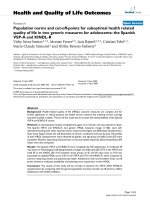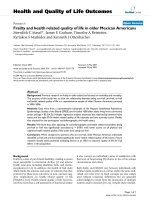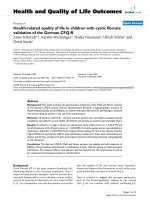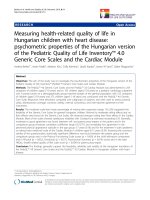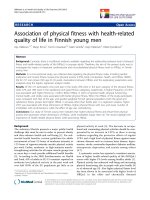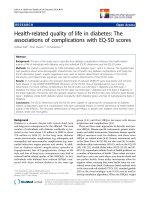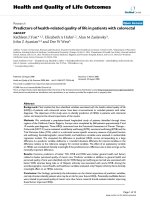báo cáo hóa học: " Population norms and cut-off-points for suboptimal health related quality of life in two generic measures for adolescents: the Spanish VSP-A and KINDL-R" pdf
Bạn đang xem bản rút gọn của tài liệu. Xem và tải ngay bản đầy đủ của tài liệu tại đây (573.37 KB, 9 trang )
BioMed Central
Page 1 of 9
(page number not for citation purposes)
Health and Quality of Life Outcomes
Open Access
Research
Population norms and cut-off-points for suboptimal health related
quality of life in two generic measures for adolescents: the Spanish
VSP-A and KINDL-R
Vicky Serra-Sutton*
1,2
, Montse Ferrer
2,3
, Luis Rajmil
1,2,3
, Cristian Tebé
1,2
,
Marie-Claude Simeoni
4
and Ulrike Ravens-Sieberer
5
Address:
1
Agència d'Avaluació de Tecnologia i Recerca Mèdiques, Barcelona, Spain,
2
CIBER Epidemiología y Salud Pública, CIBERESP, Spain,
3
Institut Municipal d'Investigació Mèdica, Barcelona, Spain,
4
Service de Santé Publique. EA 3279. Faculté de Médicine, Marseille, France and
5
Building W 29 (Erikahaus), University Clinic Hamburg-Eppendorf, Hamburg, Germany
Email: Vicky Serra-Sutton* - ; Montse Ferrer - ; Luis Rajmil - ;
Cristian Tebé - ; Marie-Claude Simeoni - ; Ulrike Ravens-
Sieberer -
* Corresponding author
Abstract
Background: Health-related quality of life (HRQL) outcome measures are complex and for
further application in clinical practice and health service research the meaning of their scorings
should be studied in depth. The aim of this study was to increase the interpretability of the Spanish
VSP-A and KINDL-R scores.
Methods: A representative sample of adolescents aged 12 to 18 years old was selected in Spain.
The Spanish VSP-A and KINDL-R, two generic HRQL measures (range: 0–100), were self-
administered along with other external anchor measures (Strengths and Difficulties Questionnaire,
Oslo Social Support Scale and self-declaration of chronic conditions) and sent by post. Percentiles
of both HRQL questionnaires were obtained by gender, and age group and effect sizes (ES) were
calculated. Receiver Operating Characteristic curves and related sensitivity (SE) and specificity (SP)
values were also computed.
Results: The Spanish VSP-A and KINDL-R were completed by 555 adolescents. A moderate ES
was shown in Psychological well-being between younger and older girls (ES: 0.77) in the VSP-A and
small ES in the KINDL (ES: 0.41) between these groups. A SE and SP value close to 0.70 was
associated to a global HRQL score of 65 in the VSP-A and 70 in the KINDL-R, when compared to
anchors measuring mental and psychosocial health. Adolescents with scores bellow these cut-off
points showed a moderate probability of presenting more impairment in their HRQL.
Conclusion: The results of this study will be of help to interpret the VSP-A AND KINDL-R
questionnaires by comparing with the general population and also provide cut-off points to define
adolescents with health problems.
Published: 21 April 2009
Health and Quality of Life Outcomes 2009, 7:35 doi:10.1186/1477-7525-7-35
Received: 13 June 2008
Accepted: 21 April 2009
This article is available from: />© 2009 Serra-Sutton et al; licensee BioMed Central Ltd.
This is an Open Access article distributed under the terms of the Creative Commons Attribution License ( />),
which permits unrestricted use, distribution, and reproduction in any medium, provided the original work is properly cited.
Health and Quality of Life Outcomes 2009, 7:35 />Page 2 of 9
(page number not for citation purposes)
Background
Measurement of health related quality of life (HRQL)
started in the 70's as a complement to traditional clinical
outcomes. As a consequence of the increase in the survival
of chronic conditions and life expectancy, healthcare has
gone beyond the cure of illness. These facts and also a
greater implication of patients in clinical decision making,
have lead to the use of more subjective outcomes to meas-
ure the effectiveness of treatments such as HRQL [1]. The
most extended definition of this outcome presents a mul-
tidimensional perspective that includes patients or popu-
lations' points of view of their health, and also the
influence on their ability to deal with daily activities con-
sidered important for individuals [2]. Many health-related
quality of life (HRQL) measures have been developed for
children and adolescents in the last decade. However,
their use is still limited and restricted mainly to research
areas. To generalize their application in different contexts,
interpretation has been identified as one of the main bar-
riers.
Several authors have argued [3,4], that scores of HRQL by
themselves are difficult to interpret. Thus, interpretability
implies the degree to which one can assign easily under-
stood meaning to an instrument's quantitative score.
There are different approaches to facilitate the interpreta-
bility of HRQL scores; one of the most used for generic
questionnaires is the application of normative values
from general populations [5]. This strategy allows com-
paring individuals or groups of patients with the distribu-
tion of scores, and help putting into context an individual
or group score by comparing it with a corresponding ref-
erence group [6]. Furthermore, we are also interested in
defining cut-off points for groups with more impaired
HRQL. Generally, the selection is made in terms of the
distribution deciding which proportion of the population
would be in the group of ill health. For example, half of
the population if we select the median, or the 30% with
worst scores in the case of a percentile 30. However, it is
an arbitrary decision and a meaning is not provided to a
given cut-off point. For this purpose, independent well-
known indicators could help to select the most appropri-
ate HRQL cut-off point and could provide a direct health
meaning. For this anchor strategy, different indicators
such as mortality or disease diagnoses have been used [7].
This strategy has been commonly used to interpret scores
of mental health scales such in the case of the Chid Behav-
iour Checklist (CBCL) [8] or the Strengths and Difficulties
Questionnaire (SDQ) [9] to differentiate an ill mental
health status from a healthy one. Nevertheless, few studies
have addressed these issues of interpretability using
HRQL questionnaires in child or adolescent populations.
Finally, the simultaneous comparison of questionnaires
also has proved to be of use in gaining interpretation of
their scorings [10]. Issues such as the content, nature of
development and cultural context of the HRQL measures
could make scores differ for similar domains. The Spanish
versions of the French Vecú Santé Perçue de l'Adolescent
(VSP-A) and the German Questionnaire for measuring
health-related quality of life in children and adolescents
(KINDL), two generic HRQL questionnaires, were
adapted in parallel and were included in the Kidscreen
project as validation instruments [11]. As part of the proc-
ess of obtaining the Spanish versions, interpretability
issues were defined. The aims of this study were to facili-
tate the interpretation of the Spanish VSP-A and KINDL-R
by obtaining general population based reference norms
and identifying appropriate cut-off points to define prob-
abilities of worse HRQL compared to external anchors. A
simultaneous comparison of the results of both measures
was also carried out.
Methods
Design and sample selection
This study was based on a cross-sectional descriptive tele-
phone and postal survey carried out simultaneously in 13
European countries in the context of the Kidscreen
project. The first stage of sample selection was carried out
by telephone using the random digital dialling technique.
A sample size of 1800 children and adolescents per coun-
try was considered necessary to detect a minimally impor-
tant difference of half a standard deviation (SD) in HRQL
scores, and it has been described in more detail elsewhere
[12]. The sample frame was all households with a fixed
telephone line and with children and adolescents aged 8–
18. For comparison reasons between questionnaires, only
the sub-sample of adolescents was included in the present
study. Data protection requirements of the European Par-
liament were followed and checked by the European
Commission (Directive 95/46/EC of the European Parlia-
ment). Parents consent was received to participate in the
mail survey. If parents and adolescents agreed to partici-
pate when contacted by telephone, a postal survey was
sent to them. A sample of 577 adolescents completed a
self-administered survey at home and sent it back to
research team by post. The fieldwork was carried out
between April 2003 and November 2003. The postal
response rate was 44.9% in the case of Spain and 555
cases were finally included in this study. A percentage of
3.8 adolescents presented incomplete information or
were either younger than 12 or older than 18.
Description of the instruments and variables
The Spanish versions of the VSP-A and KINDL-R were
administered together with other demographic and health
status variables.
The VSP-A and the KINDL-R are two generic HRQL meas-
ures that were developed in France and Germany respec-
tively [13,14]. The VSP-A was developed for adolescents
aged 11 to 17 and includes 39 items distributed in 9
Health and Quality of Life Outcomes 2009, 7:35 />Page 3 of 9
(page number not for citation purposes)
domains: "Vitality", "Physical well being (WB)", "Psycho-
logical well being (WB)", "Body image", "Relations with
friends", "Relations with parents", "Relations with teach-
ers", "School work", "Leisure", and two additional mod-
ules that report information on "Relations with health
professionals" and on "Sentimental and sexual life" (these
two latter modules were not assessed in this study). In
addition to dimension scores, the VSP-A allows the gener-
ation of a global score and index of HRQL (12 item ver-
sion) [15]. The KINDL-R was developed for children and
adolescents aged 8–11 (Kid-KINDL) and 12–16 (Kiddo-
KINDL). It includes 24 items distributed in 6 domains:
"Physical well being (WB)", "Psychological well being
(WB)", "Self-esteem", "Family", "Friends" and "School"
and additional modules for children and adolescents with
chronic conditions (not assessed in this study) and allows
creating a global HRQL score. Both HRQL measures
include a Likert scale with 5 options in a 4-week and 1-
week recall period, respectively. Domain scores include a
score range of 0 to 100. Higher scores indicate better
HRQL. For comparison reasons, the versions assessed in
this study were the Spanish VSP-A and Spanish Kiddo-
KINDL-R, administered to adolescents aged 12–18.
Other socio-demographic and health variables
Socio-demographic variables were also collected from
adolescents such as sex and age (12–15, 16–18 years old)
and perceived socio-economic status using the Family
Affluence Scale (FAS) [16]. Other variables included the
self-declaration of a chronic condition collected from a
checklist (yes, no) and the Strengths and Difficulties
Questionnaire (SDQ), a brief behavioural screening ques-
tionnaire that allows the classification of children and
adolescents in healthy, borderline or noticeable mental
health groups [9,17]. The Oslo Social Support Scale,
which consists of 3 items, was also administered and cat-
egorized as strong, moderate and poor social support
[18,19]. This scale collects information on the number of
people who can provide a sense of security to the adoles-
cent in terms of instrumental and emotional support.
These versions were answered by parents in the case of the
SDQ and by adolescents in the case of socio-demograph-
ical variables, Oslo Scale, and presence of a chronic condi-
tion.
Statistical analysis
Descriptive statistics of the Spanish VSP-A and KINDL-R
domain scores were computed.
General population based reference values and magnitude of score
differences
Reference values of the Spanish VSP-A and KINDL-R were
described in a sample of adolescents after stratification by
gender and two age groups (12–15 and 16–18 years old)
as differences were expected based on finding of the orig-
inal versions and existing literature [13,14,20]. Mean,
standard deviation, and deciles were also calculated. Dis-
tribution based approaches are used for the interpretation
of HRQL questionnaires and allow to quantify the magni-
tude of score differences between groups. At cross-sec-
tional level effect sizes (ES) can be computed and
described as small (0.2–0.5), moderate (0.51–0.8) or
large (> 0.8) values.
Use of external anchors
In this study, 3 external anchors were used: the SDQ (cat-
egorized as normal versus borderline-noticeable mental
health problem), the self-declaration of a chronic condi-
tion (yes versus no); and the Oslo Social Support Scale
(categorized as poor versus moderate-high). To incorpo-
rate the information from these external anchors to the
Spanish VSP-A and KINDL-R, their frequencies were com-
puted for each of the 10 points of global HRQL scores in
each questionnaire. Receiver Operating Characteristics
(ROC) curves and the Area under the Curve (AUC) were
computed to assess the discrimination ability of selected
VSP-A and KINDL-R scores in relation to these external
anchors [21].
Sensitivity (SE) and specificity (SP) values related to an
"optimal" HRQL cut-off-point were also described. These
values are used in epidemiological studies, and especially
in diagnostic tests [22]. A SE value describes the probabil-
ity that a given measure adequately classifies an "ill" or
"exposed" individual, while a SP value describes the prob-
ability of measure to correctly classify a person that is not
"ill", or is not "exposed" to a given risk [23]. In this study,
the cut-off-scores in selected HRQL were chosen accord-
ing to the highest SE and SP values. Comparable domains
in the Spanish VSP-A and KINDL-R were selected for com-
parison with anchors measuring similar concepts. Psycho-
logical well-being domains in the VSP-A and KINDL-R
were compared with the SDQ used as an anchor measur-
ing mental health; relations with parents/parents and rela-
tions with friends/friends in both HRQL questionnaires
were compared to the Oslo Social Support Scale. In the
case of the anchor measuring physical chronic conditions,
it was compared with domains in the VSP-A and KINDL-
R of physical well-being. Finally, all selected anchors were
compared with the global HRQL scores in the VSP-A and
KINDL-R.
Results
Most adolescents were 12–15 years old (63.5%) and half
of the sample were girls (50.8%), while most declared
being from a middle socio-economic background
(51.6%), measured by the FAS (Table 1). Three percent of
the Spanish adolescent reference sample (n = 555) was
classified as suffering a noticeable mental distress meas-
ured by SDQ, 10.3% declared a physical chronic condi-
tion, and 17.5% of adolescents scored poor social
support.
Health and Quality of Life Outcomes 2009, 7:35 />Page 4 of 9
(page number not for citation purposes)
Descriptive statistics of the Spanish VSP-A and KINDL-R
More than 50% of adolescents presented scores above or
close to 70 in most VSP-A domains, except for "Relations
with teachers" and "School work" (Table 2). In the
KINDL-R, 50% of adolescents scored above 70 in all
domains, except for "School". The percentage of missing
values in this study was less than 6% in the Spanish VSP-
A domains, and less than 3% in the Spanish KINDL-R. The
questionnaires did not present any floor effect. A ceiling
effect was observed in the domains "Body Image" and
"School Work" in the VSP-A (35.3% and 16.0%, respec-
tively), and also in the "Psychological well-being",
"Friends" and "Parents" domains in the KINDL-R (19.5%,
20.8% and 25.4%, respectively).
Description of population reference values and the
magnitude of score differences
In general, the younger group presented higher (better)
scores in all domains of HRQL for both girls and boys
(please see Additional file 1 and Additional file 2). A mod-
erate effect size (ES) was shown in domains such as Psy-
chological well-being in the VSP-A between younger and
older girls (ES: 0.77), and among older teens, between
boys and girls (ES: 0.59). In the Physical well-being
domain moderate and large ES were shown (ES: 0.47
between younger and older girls; and ES: 0.81 between
boys and girls of 16 to 18 y. old). In the KINDL-R, differ-
Table 1: Description of sample by socio-demographic and health
characteristics (n = 555)
Variables N (%)
Sex/age
Girls
12–15 177 (62.8)
16–18 105 (37.2)
Boys
12–15 177 (64.8)
16–18 96 (35.2)
FAS*
Low 119 (21.6)
Middle 285 (51.6)
High 148 (26.8)
Chronic condition
No 495 (89.7)
Yes 57 (10.3)
Psychiatric or mental health (SDQ)**
Normal 455 (85.2)
Borderline 62 (11.6)
Clinical 17 (3.2)
Social support
Strong 146 (26.6)
Moderate 306 (55.8)
Poor 96 (17.5)
*FAS: Family Affluence Scale.
** SDQ: Strengths and Difficulties Questionnaire
Table 2: Descriptive results of the Spanish VSP-A and KINDL-R domains in a representative sample of non-institutionalized
adolescents in Spain (n = 555)
Domains (no. of items) Mean (SD)* Median Missing values Effect % Observed range
% Floor Ceiling Min. Max.
Spanish VSP-A
Vitality (5) 70.1 (18.6) 70.0 3.9 0.0 6.1 10.0 100.0
Physical WB** (4) 71.7 (17.4) 75.0 3.8 0.0 6.3 12.5 100.0
Psychological WB** (5) 68.7 (20.1) 70.0 3.8 0.0 6.3 5.0 100.0
Body image (2) 74.7 (27.4) 87.5 3.8 2.6 35.3 0.0 100.0
Relations w. friends (5) 77.5 (17.0) 80.0 5.2 0.0 13.0 20.0 100.0
Relations w. parents (4) 69.8 (20.6) 75.0 3.4 0.0 11.1 6.2 100.0
Relations w. teachers (3) 60.0 (25.3) 58.3 4.3 2.6 11.8 0.0 100.0
School work (2) 60.5 (28.3) 62.5 3.8 6.5 16.0 0.0 100.0
Leisure (4) 69.8 (19.6) 75.0 3.4 0.4 8.0 0.0 100.0
Global score 69.2 (14.1) 69.7 6.3 0.0 0.0 16.2 98.8
Spanish KINDL-R
Physical WB** (4) 76.9 (16.9) 81.2 2.7 0.0 11.0 12.5 100.0
Psychological WB** (4) 82.5 (15.3) 87.5 2.7 0.0 19.5 31.5 100.0
Self-esteem (4) 70.7 (20.5) 75.0 2.9 0.2 11.0 0.0 100.0
Friends (4) 82.7 (14.8) 87.5 2.1 0.0 20.8 6.2 100.0
Parents (4) 80.6 (19.3) 87.5 2.7 0.2 25.4 0.0 100.0
School (4) 53.0 (15.8) 50.0 2.9 0.0 0.0 12.5 93.7
Global score 74.5 (12.3) 76.0 2.9 0.0 0.0 28.1 97.9
*SD: standard deviation. **WB: well-being; w: with
Health and Quality of Life Outcomes 2009, 7:35 />Page 5 of 9
(page number not for citation purposes)
ences between groups were smaller, showing an ES: 0.41
for differences between older and younger girls in their
Psychological well-being, and an ES: 0.34 between older
boys and girls in their Physical well-being. These differ-
ences should be taken into account when interpreting the
normative values as girls tend to present lower scorings.
Use of external anchors
Table 3 shows the percentage of adolescents with a prob-
able psychosocial or physical chronic condition for each
of the 10-point intervals of the Spanish global HRQL
scores. Adolescents with a VSP-A global score < 50 were
more likely to present a noticeable mental health prob-
lem, or a psychosocial or chronic condition (53%, 55%
and 16%, respectively). In the case of the KINDL-R, ado-
lescents with a global HRQL score < 50 showed the high-
est probability of presenting a noticeable mental health
problem, a psychosocial problem or chronic condition
(67%, 80% and 20% respectively). On the other hand,
global HRQL scores near 80 reflect a low probability (11%
for VSPA and 16% for KINDL-R) of presenting any of
these health problems.
Figures 1, 2, 3 and 4 show the ROC curves of the Spanish
VSP-A and KINDL-R global and selected domain scores to
predict more impaired HRQL. The agreement between
"Psychological well-being" and global HRQL scores with
a probable borderline-noticeable mental health problem
(Figure 1 and Figure 2) was very similar for both question-
naires (AUC around 0.8). The discrimination ability of
the domains measuring social HRQL (Figure 3 and Figure
4) such as family and friend relationship domains in the
VSP-A and KINDL-R when compared to poor social sup-
port (measured by the Oslo scale), showed that the VSP-A
presented a higher AUC (0.77) compared to the KINDL-R
(range: 0.68 – 0.70). In the case of "Physical well-being"
scores in the VSP-A and KINDL-R, and reported chronic
condition (data not shown), the AUC were lower and sim-
ilar for both questionnaires (AUC = 0.63 and 0.64 for
VSP-A and KINDL-R, respectively). For global HRQL
scores, this agreement was higher for the VSP-A question-
naire (AUC of 0.70 versus 0.60). Regarding the selection
of a cut-off point in the Spanish global VSP-A closest to
65.0, a sensitivity value (SE) of 0.72 to 0.74, and specifi-
city value (SP) of 0.70 to 0.72 were shown in relation to a
probable noticeable mental health problem or psychoso-
cial health problem. In the Spanish KINDL-R, a global
score close to 70.0 was related to a SE value of 0.70 to
0.73, for the screening of a probable mental or psychoso-
cial health problem and a SP associated value between
0.70 and 0.63, respectively.
Discussion
The results of this study allow increasing the possibilities
for interpretation of two generic HRQL questionnaires in
future studies where the questionnaires are applied. Inter-
pretation strategies imply more than the assessment of
validity; they should potentially include the interpretabil-
ity of scores for researchers, clinicians, decision makers
and patients or general society. A study that included the
content analysis of selected generic HRQL measures for
these age groups has shown that similar instruments show
different contents, even for apparently similar domains
such as physical or psychological well-being [24]. In the
context of paediatric measures, some research teams have
defined the model of the instrument based on literature or
expert consensus, and included the opinion of children or
adolescents for the definition of item content. This is also
Table 3: Perceptual distribution (%) of participants in the Spanish reference sample with a psychosocial or chronic health problem
according to their global HRQL score in the Spanish VSP-A and KINDL-R
total sample adolescents with a borderline-
noticeable mental problem
b
adolescents with low social
support
c
adolescents with a self-
declared chronic condition
adolescents with any of the 3
health problems
Global VSP-A N
d
n (%) n (%) n (%) n (%)
0-49.9a 49 25 (53.2)
e
27 (55.1) 8 (16.3) 37 (75.5)
50–59.9 77 25 (32.9) 22 (29.3) 7 (9.2) 40 (52.0)
60–69.9 140 16 (11.7) 27 (19.4) 11 (7.9) 49 (35.0)
70–79.9 129 9 (7.0) 9 (7.1) 4 (3.1) 21 (16.3)
80–89.9 100 3 (3.0) 5 (5.1) 3 (3.0) 11 (11.0)
90–100 29 0 (0.0) 1 (3.6) 0 (0.0) 1 (3.4)
Global KINDL-R N n (%) n (%) n (%) n (%)
0–49.9
a
15 10 (66.7) 12 (80.0) 3 (20.0) 15 (100.0)
50–59.9 57 24 (42.1) 16 (28.6) 6 (10.5) 33 (58.0)
60–69.9 107 17 (17.3) 26 (25.0) 9 (8.5) 45 (42.0)
70–79.9 167 15 (9.0) 25 (15.2) 9 (5.4) 42 (25.1)
80–89.9 143 7 (5.2) 10 (7.1) 8 (5.6) 23 (16.0)
90–100 54 0 (0.0) 2 (3.8) 1 (1.9) 3 (5.0)
HRQL: health related quality of life.
a
due to small number of cases included in scores between 0 and 49.9 they were re-categorized in one group.
b
measured with the SDQ.
c
measured with the Oslo Scale.
d
missing values are presented in some subgroups.
e
the percent value of each cell is computed as: n in the cell/N in the whole sample [Example,
n:25/N:47 = (53.2). Note 2 missing values in the SDQ, N = 49].
Health and Quality of Life Outcomes 2009, 7:35 />Page 6 of 9
(page number not for citation purposes)
the case of the KINDL-R questionnaire [14]. The VSP-A
was developed using exclusively the opinion of adoles-
cents for defining item and domain content [13]. The final
model included in both questionnaires has been defined
through psychometric testing.
Results of psychometric testing of the Spanish versions of
the VSP-A and KINDL-R have shown acceptable validity
and reliability coefficients [25,26]. Even if some differ-
ences were shown regarding discrimination abilities of
specific domains in the VSP-A and KINDL-R, there have
shown similar values regarding AUC or SE and SP values
to detect those adolescents with more impairment in their
HRQL. These results imply that both instruments are ade-
quate for describing health needs of adolescents and for
their application in health service research in Spain. More-
over, the use of the Spanish VSP-A and KINDL-R in future
applied studies will allow continuing the assessment of
their validity and longitudinal reproducibility in groups
with different clinical or socio-demographical characteris-
tics. The results of the present study will aid potential
users of these questionnaires in interpreting the results of
their own studies.
General population-based reference norms are the
approach used for height and weight in the assessment of
paediatric growth and it is also the interpretation strategy
most used for generic HRQL. The use of percentiles to
describe scores does not require assumptions of normal
distributions and makes it possible to interpret the HRQL
scores: 1) it provides with information on the amount of
HRQL impairment of an individual or a group by compar-
ing the score obtained, with the distribution of scores of
the corresponding population; 2) differences in percentile
position may help to determine the size of score differ-
ences, observed either in a child over time or between two
groups or individuals. On the other hand, reference
norms could also help to fix therapeutic objectives taking
into account that the maximum theoretical score of a
questionnaire would not be considered the maximum
attainable. In fact, although the VSP-A and the KINDL-R
have scores ranging from 0 to 100 (the best HRQL), very
few teenagers score this maximum. When interpreting
longitudinal changes [7,27], these population reference
values also can help to interpret how far scores of patients
are before treatment, and if they achieve scores close to the
normative values after the intervention.
ROC curves for adolescents' scores in Psychological Well-being and Global scores in the Spanish VSP-A versus a bor-derline-noticeable mental health problem (measured by SDQ)Figure 1
ROC curves for adolescents' scores in Psychological
Well-being and Global scores in the Spanish VSP-A
versus a borderline-noticeable mental health prob-
lem (measured by SDQ). AUC: Area Under Curve; 95%
CI: 95% Confidence Interval; SE: Sensitivity; SP: Specificity.
[Black line] Psychological well-being AUC: 0.78 (95% CI:
0.73–0.84) Optimal cut-off-point: 61.2. SE: 0.73 SP: 0.72
[Dashed line] Global HRQL score AUC: 0.80 (95% CI: 0.75–
0.85) Optimal cut-off-point: 63.7 SE: 0.74 SP: 0.70
ROC curves for adolescents' scores in Psychological Well-being and Global scores in the Spanish KINDL-R versus a borderline-noticeable mental health problem (measured by SDQ)Figure 2
ROC curves for adolescents' scores in Psychological
Well-being and Global scores in the Spanish KINDL-
R versus a borderline-noticeable mental health prob-
lem (measured by SDQ). AUC: Area Under Curve; 95%
CI: 95% Confidence Interval; SE: Sensitivity; SP: Specificity.
[Black line] Psychological well-being. AUC: 0.76 (95% CI:
0.70–0.83). Optimal cut-off-point: 78.1 SE: 0.71 SP: 0.68.
[Dashed line] Global HRQL score. AUC: 0.80 (95% CI: 0.74–
0.86). Optimal cut-off-point: 70.1 SE: 0.73 SP: 0.70
Health and Quality of Life Outcomes 2009, 7:35 />Page 7 of 9
(page number not for citation purposes)
Differences in age and gender should be taken into
account when assessing the meaning of "healthy" or "ill"
HRQL scores. Girls in this study have reported lower vital-
ity, physical and psychological well-being and lower
scores in general, compared to boys. These results are con-
sistent with the original version results and other studies
that have applied HRQL measures in adolescents and also
imply that the same score could have different meaning
according to the individual or group evaluated. Consist-
ent findings in the literature have presented a gender pat-
tern in favour of boys and younger teens in several
international studies [28,29]. These differences could be
due to girls presenting more health needs, or even express-
ing them more openly than boys. The definition of the age
groups in the present study has been due to a theoretical
perspective following the organization of the Educational
and Health System in Spain. Adolescents attend ESO (Sec-
ondary Obligatory School) from 12 to 15 years old and
then High School from 16 to 18 years old. Moreover, Pae-
diatric services are defined for children and adolescents up
to 15 years old. Previous studies in Spain using similar age
groups have shown similar results in younger and older
adolescents' HRQL scores [20]. Regarding the impact of
pubertal changes on HRQL, a study published by the Kid-
screen group showed that the most relevant changes when
comparing groups aged 8–18 are at the age of 12–13 in
relation to younger children, especially in their physical
and psychological well-being. From these ages onwards,
their HRQL scores worsen gradually [29]. Future studies
including greater and longitudinally based samples could
help to study the impact of age developmental process on
HRQL scores in Spanish children and adolescents using
the VSP-A and KINDL-R questionnaires.
The use of cut-off points also help in the interpretation of
HRQL scores together with the use of norm values [3,5].
The cut-off points identified by the external anchors for
the Spanish VSP-A and KINDL-R, have potentially
allowed differentiating 'healthy' groups from groups with
more impairment in their HRQL. In other studies that
include mental health scales to distinguish a normal score
from a psychiatric health problem or other studies of
HRQL also include the definition of cut-off points, either
ROC curves for adolescents' scores in Relations with Friends, Relations with Parents and Global score in the Span-ish VSP-A versus poor social support (measured by the Oslo Social Support scale)Figure 3
ROC curves for adolescents' scores in Relations with
Friends, Relations with Parents and Global score in
the Spanish VSP-A versus poor social support (meas-
ured by the Oslo Social Support scale). AUC: Area
Under Curve; 95% CI: 95% Confidence Interval; SE: Sensitiv-
ity; SP: Specificity. [Black line] Relation with parents. AUC:
0.77 (95% CI: 0.72–0.82). Optimal cut-off-point: 60.4 SE: 0.76
SP: 0.64. [Dotted line] Relation with friends. AUC: 0.77 (95%
CI: 0.72–0.82). Optimal cut-off-point: 67.5 SE: 0.78 SP: 0.59.
[Dashed line] Global HRQL score. AUC: 0.77 (95% CI: 0.71–
0.82). Optimal cut-off-point: 64.8 SE: 0.72 SP: 0.72
ROC curves for adolescents' scores in Friends, Parents and Global score in the Spanish KINDL-R versus poor social sup-port (measured by the Oslo Social Support scale)Figure 4
ROC curves for adolescents' scores in Friends, Par-
ents and Global score in the Spanish KINDL-R versus
poor social support (measured by the Oslo Social
Support scale). AUC: Area Under Curve; 95% CI: 95%
Confidence Interval; SE: Sensitivity; SP: Specificity [Black line]
Parents AUC: 0.68 (95% CI: 0.62–0.74) Optimal cut-off-
point: 71.9 SE: 0.77 SP: 0.52 [Dotted line] Friends AUC: 0.70
(95% CI: 0.63–0.76) Optimal cut-off-point: 78.1 SE: 0.68 SP:
0.62 [Dashed line] Global HRQL score AUC: 0.72 (95% CI:
0.67–0.78) Optimal cut-off-point: 71.3 SE: 0.70 SP: 0.63
Health and Quality of Life Outcomes 2009, 7:35 />Page 8 of 9
(page number not for citation purposes)
based on conceptual and empirical strategies comparing
scores with diagnostic groups or using cluster analysis to
test the classification of cases in "healthy" or "ill health"
[8,30]. In our study, the use of SE and SP values related to
a given cut-off point helped to assess how well a test is dis-
criminating between groups [22]. Optimal SE and SP val-
ues are those that find the highest value for both
estimators. In this study the optimal SE and SP values
were associated to a global score close to 65.0 in the VSP-
A and close to 70.0 in the KINDL-R and imply that adoles-
cents with these scores show a moderate probability of
being in good health.
Limitations of this study should be mentioned. Even if the
sample design aimed to obtain a representative, non-insti-
tutionalised sample of adolescents in Spain, the sampling
method based on a telephone interview and postal survey
caused a lower response rate than other administration
methods (ex. school based) in the Spanish context. More
detail of the representativeness of this sample can be
found in another published study of the Kidscreen project
[12]. A short phone interview of non-responses was car-
ried out in Spain. As a result, analysis of representative-
ness showed that, in general, it was acceptable compared
to EUROSTAT data regarding age and sex. The lower than
expected response rate obtained in this study (45%
instead of 70%) has introduced a limitation in the strati-
fication of the sample by each age. This fact has also intro-
duced a probable response bias implying infra-
estimations of HRQL scores in the Spanish sample. The
use of both instruments in different populations, includ-
ing clinical samples and from different geographical areas
in Spain will allow for continuing the validation and
interpretation strategies as recommended in the literature.
The application of these measures in clinical samples will
be needed to increase the interpretability of scores in ill
adolescents compared to the reference values in this
study. Longitudinal studies will increase the interpretabil-
ity of scores of these questionnaires to detect changes over
time when a health intervention has been implemented.
Finally, even if clinical information could not be obtained
and medical conditions were self-reported, the screening
measures used in the present study have helped to inter-
pret the scores of HRQL domains setting cut-of-points of
adequate health.
The applicability of HRQL measures for children and ado-
lescents are similar for those in adult ages such as the iden-
tification of health needs, studies to determine risk
factors, assessment of effectiveness and efficacy of health
services, monitoring of health at population and clinical
level, health planning or priority setting [1,3,31]. Never-
theless, applied studies are much less frequent in these age
groups mainly because there has been a process of devel-
opment and psychometric testing before available meas-
ures could be used. Some of the challenges for the
measurement of HRQL in paediatric ages imply the use of
this outcome to deepen in the knowledge of factors
related to better or worse health status or use in clinical
practice and public health for the assessment of health
interventions.
Conclusion
The results of this study will be of use for future users of
the Spanish VSP-A and KINDL-R questionnaires, espe-
cially to assess how close or not scores are from those con-
sidered as "healthy" HRQL. Moreover, the increase in the
use of HRQL in the evaluation of health-care makes it nec-
essary not only to assess if scores improve after an inter-
vention, but also if they reach similar population
reference values.
Abbreviations
VSP-A: Vecú Santé Perçue de l'Adolescent;KINDL: Ques-
tionnaire for measuring health-related quality of life in
children and adolescents; HRQL: Health-Related Quality
of Life; CBCL: Child Behaviour Checklist; SDQ: Strength
and Difficulties Questionnaire; SD: Standard Deviation;
ES: Effect Size; ROC: Receiver Operating Characteristic;
AUC: Area under the Curve; SE: Sensitivity; SP: Specificity;
CI95%: Confidence interval 95%; WB: Well-Being
Competing interests
The authors declare that they have no competing interests.
Authors' contributions
VSS, MF contributed to the design of this study, analysed
data and co-wrote this paper. LR is the Principal Investiga-
tor, contributed to the design of this study and com-
mented on this paper.
CT, MCS and URS commented on this paper. MCS and
URS are the original authors of the VSP-A and KINDL-R
respectively. URS is also the coordinator of the Kidscreen
project.
Additional material
Additional file 1
Population reference values of the Spanish VSP-A by age and gender
(P: Percentiles. Spain n = 555). Additional table
Click here for file
[ />7525-7-35-S1.doc]
Additional file 2
Population reference values of the Spanish KINDL-R by age and gen-
der (P: Percentiles. Spain n = 555). Additional table
Click here for file
[ />7525-7-35-S2.doc]
Publish with BioMed Central and every
scientist can read your work free of charge
"BioMed Central will be the most significant development for
disseminating the results of biomedical research in our lifetime."
Sir Paul Nurse, Cancer Research UK
Your research papers will be:
available free of charge to the entire biomedical community
peer reviewed and published immediately upon acceptance
cited in PubMed and archived on PubMed Central
yours — you keep the copyright
Submit your manuscript here:
/>BioMedcentral
Health and Quality of Life Outcomes 2009, 7:35 />Page 9 of 9
(page number not for citation purposes)
Acknowledgements
This project was partially financed by the Fondo de Investigación Sanitaria,
Spanish Ministry of Health (contract n° PI0212206) the Network of excel-
lence on Health Outcomes and Health Services Research IRYSS (contract
n° G03/202), and the Kidscreen project financed by the European Commis-
sion (contract n° QLG-CT-2000-00751). The Catalan Government has rec-
ognised the Catalan Agency for Health Technology Assessment and
Research as a Health Service and Outcomes Research Group
(2005SGR00171). The authors would like to thank Maite Solans for her
help in the fieldwork and Alejandro Lorenzo who is a bio-medical translator
for his revision of the English grammar and style. Finally, the authors
acknowledge the comments and suggestions of anonymous reviewers that
have also helped to improve the manuscript.
References
1. Carr JA, Higginson IJ, Robinson PG: Quality of life. London: BMJ
Books; 2003.
2. Guayatt GH, Feeny DH, Patrick DL: Measuring health-related
quality of life. Ann Int Med 1993, 118:622-629.
3. Ware JE, Keller SD: Interpreting general health measures. In
Quality of life and pharmacoeconomics in clinical trials Edited by: Spilker
B. Philadelphia: Lippincott-Raven Publishers; 1996.
4. Scientific Advisory Committee of the Medical Outcomes Trust:
Assessing health status and quality of life instruments:
attributes and review criteria. Qual Life Res 2002, 11:193-205.
5. Gandek B, Ware J: Methods for validating and norming trans-
lations of health status questionnaires: the IQOLA project
approach. J Clin Epidemiol 1998, 51:953-959.
6. Streiner DL, Norman GR: Health measurement scales. A prac-
tical guide for their development and use. Oxford: Oxford
University Press; 2003.
7. Gordon G, Osoba D, Wu AW, Wyrwich KW, Geoffrey NR: Meth-
ods to explain the clinical significance of health status meas-
ures. Mayo Clin Proc. 2002, 77(4):371-383.
8. Achenbach TM, Rescorla LA: Manual for the ASEBA school-Age
forms & profiles. An integrated system of multi-informant
assessment. Burlington: ASEBA; 2001.
9. Goodman R, Ford T, Simmons H, Gatward R, Meltzer H: Using the
Strengths and Difficulties Questionnaire (SDQ) to screen for
child psychiatric disorders in a community sample. Br J Psychi-
atry 2000, 177:534-539.
10. Prieto L, Alonso J, Ferrer M, Antó JM: Are results of the SF-36
Health Survey and the Nottingham Health Profile Similar? A
comparison in COPD Patients. J Clin Epidemiol 1997, 50:463-473.
11. Ravens-Sieberer U, Gosch A, Abel T, Auquier P, Bellach PM, Bruil J,
Dür W, Power M, Rajmil L, European KIDSCREEN Group: Quality
of life in children and adolescents: a European public health
perspective. Soz Praventivmed 2001, 46:294-302.
12. Berra S, Ravens-Sieberer U, Erhart M, Tebé C, Bisegger C, Duer W,
von Rueden U, Herdman M, Alonso J, Rajmil L, European KID-
SCREEN group [kidscreen]: Methods and representativeness of
European surveys in children and adolescents: the Kidscreen
study.
BMC Public Health 2007 [ />1471-2458/7/182].
13. Simeoni MC, Auquier P, Antoniotti S, Sapin C, San Marco SL: Valida-
tion of a French health-related quality of life instrument for
adolescents: the VSP-A. Qual Life Res 2000, 9:393-403.
14. Ravens-Sieberer U, Bullinger M: Assessing health-related quality
of life in chronically ill children with the German KINDL:
First psychometric and content analytical results. Qual Life
Res 1998, 7:399-407.
15. Sapin C, Antoniotti S, Simeoni MC, Clement A, El Khammar M,
Auquier P: Shortening the VSP-A: Preliminary development
of the VSP-A12. A 12-item short-form. Qual Life Res 2004,
13:235-241.
16. Currie CE, Elton RA, Todd J, Platt S: Indicators of socioeconomic
status for adolescents: the WHO Health Behavior in School-
aged Children Survey. Health Educ Res 1997, 12:385-397.
17. Marzocchi GM, Capron C, di Pietro M, Duran Tauleria E, Duyme M,
Frigerio A, Gaspar MF, Hamilton H, Pithon G, Simões A, Thérond C:
The use of the Strenghts and Difficulties Questionnaires
(SDQ) in Southern European countries. Eur Child Adolesc Psychi-
atry 2004, 13 Suppl 2:II40-II46.
18. Stanfeld SA: Social support and social cohesion. In Social deter-
minants of health Edited by: Marmot M, Wilkinson RG. Oxford:
Oxford University Press; 1999.
19. Cohen S, Underwood LG, Gottlieb BH: Social support measure-
ment and intervention. A guide for health and social scien-
tists. Oxford: Oxford University Press; 2000.
20. Alonso J, Urzola D, Serra-Sutton V, Tebe C, Starfield B, Riley AW,
Rajmil L: Validity of the health profile-types of the Spanish
Child Health and Illness Profile-Adolescent Edition (CHIP-
AE). Value Health 2008, 11:440-449.
21. Swets JA: Measuring the accuracy of diagnostic system. Science
1998, 240:1285-1293.
22. Szklo M, Nieto FJ: Epidemiology: beyond the basics. Maryland,
Aspen Publishers; 2000.
23. Argimon Pallás JM, Jiménez Villa J: Métodos de investigación clínica
y epidemiológica. [Clinical and epidemiological research
methods]. Madrid: Ediciones Harcourt; 2000.
24. Rajmil L, Herdman M, Fernandez de Sanmamed MJ, Detmar S, Bruil J,
Ravens-Sieberer U, Bullinger M, Simeoni MC, Auquier P, Kidscreen
Group:
Generic health-related quality of life instruments in
children and adolescents: a qualitative analysis of the con-
tent. J Adolesc Health 2004, 34:37-45.
25. Serra-Sutton V, Rajmil L, Berra S, Herdman M, Aymerich M, Ferrer M,
Robitail S, Siméoni MC: Fiabilidad y validez del cuestionario de
salud y calidad de vida para adolescentes Vecú et Santé Perçue
de l'Adolescent (VSP-A). [Reliability and validity of the Spanish
version of the health and quality-of-life questionnaire, the
Vecú et Santé Perçue de l'Adolescent (VSP-A)]. Aten Primaria
2006, 37:203-208.
26. Rajmil L, Serra-Sutton V, Fernandez López JA, Berra S, Aymerich M,
Cieza A, Ferrer M, Bullinger M, Ravens-Sieberer U: Versión española
del cuestionario alemán de calidad de vida relacionada con la
salud en población infantil y de adolescentes: el KINDL. [The
Spanish version of the German health-related quality of life
questionnaire for children and adolescents. The KINDL]. An
Pediatria 2004, 60:514-521.
27. Walters SJ, Brazier JE: What is the relationship between the
minimally important difference and health state utility val-
ues? The case of the SF-6D. Health Qual Life Outcomes. 2003, 1:4.
28. Sweeting H: Reversals of fortune? Sex differences in health in
childhood and adolescence. Soc Sci Med 1995, 40:77-90.
29. Bisegger C, Cloetta B, von Rueden U, Abel T, Ravens-Sieberer U:
Health-related quality of life: gender differences in childhood
and adolescence. Soz Praventivmed 2005, 50:281-91.
30. Riley AW, Forrest CB, Starfield B, Green B, Kang M, Ensminger M:
Reliability and validity of the adolescent health profile-types.
Med Care 1998, 36:1237-1248.
31. Asadi-Lari M, Tamburini M, Gray D: Patients' needs, satisfaction
and health-related quality of life: towards a comprehensive
model. Health Qual Life Outcomes 2004, 2:32.

